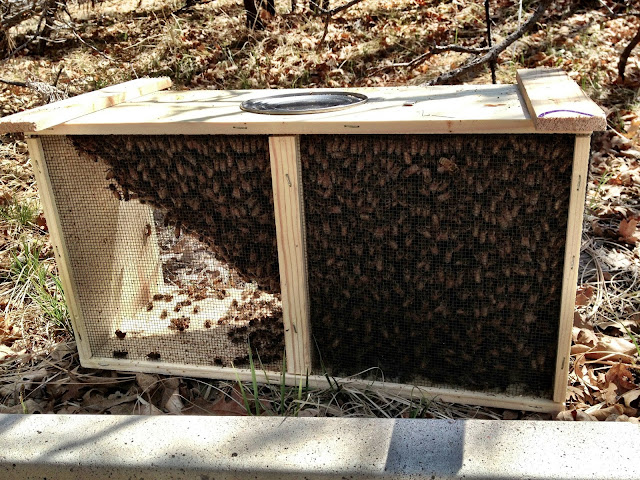The Grand Girls are gone. No, my package colony did not up and die, but as Don the Bee Mentor has taught me, "A queen is a colony and a colony is a queen." Let me explain.
I picked up my package bees - the Grand Girls - from
Apis Hive Co. at
Denver Urban Homesteading at the beginning of May, and drove home with a buzzing backend and an anxious eye to potential car accidents. The bees of my imagination were suddenly oh so real.
Jude was fascinated and unafraid, which fueled my dreams of a future beekeeper in the making!
These original package bees had a marked queen who was easy to spot with her hot pink dot. When I installed the package I followed the instructions of Apis Hive Co. and removed the cork from the queen box and replaced it with a small marshmallow. The box was inserted into the hive, the bees were shaken over the top, and I utilized a baggie feeder of sugar syrup and an empty deep to ease their transition. Then I left the girls to their own devices for a week to allow the worker bees time to eat through the candy and free their newly accepted queen.
Upon first inspection a week later, there was comb being drawn and the queen was spotted, but the bees were too crowded to see what was happening within the comb itself.
And then came week 2, inspection #2...Bees, comb, pollen...no queen. No eggs. No baby bees. Me, freaking out that I somehow sentenced this colony to an early death with my inept beekeeping skills.
Enter Don the Bee Mentor!
Sidetrack: I must reiterate how wonderful it is to have a flesh and blood human being to turn to in times of bee crisis. And for a new beekeeper, these times are plentiful. I've read a hundred books, blogs and forums but nothing tops a teacher. For novice beekeepers lucky enough to live in the Denver area, Don offers a yearlong mentoring program that will teach everything from routine inspection, to splitting your hives (I can personally attest to the magic and relevance of this particular skill set), to managing varroa mites without pesticides, to harvesting that pot of gold at the end of the rainbow, HONEY. For beekeepers outside my area, I urge you to contact your local bee clubs and find a skilled mentor to apprentice yourself to. Bees may not require large amounts of your time, but they require finesse and a vast base knowledge that benefits from hands-on instruction. Back to the original story...
Don talked me off my crazy tangent and let me know that there were a few possible reasons for the loss of the queen and they weren't, as in
the case of our poor chicks, a result of me. First, she may not have been mated properly. She may have been released too quickly and killed by the colony. She may have flown off. And finally, she's a bug - maybe she just died.
I had about a week, since the bees had been without a queen for at least 5 days, to get a new queen before a worker started laying drones (bad news) and/or the current colony started dying of old age. This is when Don sent me to Tim Brod of
Highland Honey Bees.
Tim, of the "
stung on the eyelid" posting of yore, happened to be boxing queens within the next two days. Lucky me! I drove to Boulder on a random afternoon, purchased a queen and received her majesty and a few attendants in a disposable coffee cup, and drove home. Fun drive.

Don and Tim both instructed me on a different, and (spoiler alert!) more successful, way to hive a queen. Keeping the cork intact, I sandwiched the queen box between 2 frames in the hive and left her for 3 days. I checked back in and noticed that the bees were not being particularly gentle with the queen box - attempting to sting it and buzzing at an uncomfortable level while I was inspecting the hive. Playing it safe, I left the queen in the box for another day and then revisited the hive on her 4th morning in residence. What a change! The bees were calm and though they were drawn to the box they were not trying to hurt her. I carefully shook the queen to the bottom of the box, pushed in the cork with a nail, and placed her on top of the frames. She exited immediately and disappeared into the hive.
And now? Well, the Carniolan Grand Girls will help attend to a new line of Carniolan/Italian hybrids that will replace them when they are gone. I inspected the hive yesterday (no pics - I was racing an afternoon thunderstorm) and while I did not see the queen...I did see bee larvae! For the first time, this colony of bees is on its way to being a successful superorganism. Though they are off to a late start, and I don't expect any surplus honey from the ladies this season, I have great expectations of being able to shepherd the bees into a successful survival of winter.
Now, all that is left is the naming of the new colony. Any suggestions?






